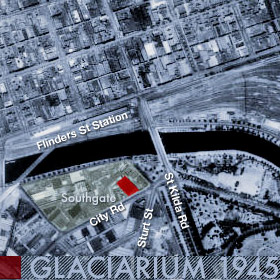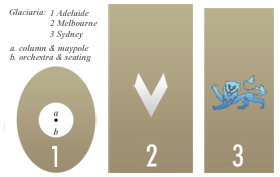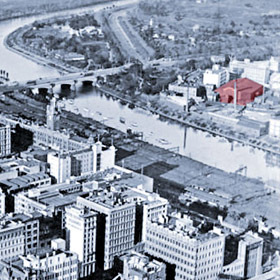Legends
home
Melbourne Glaciarium
1906 - 1957
World's 3rd Largest Rink
+ Melbourne Glaciarium, 1906
SOON AFTER REID'S ADELAIDE experiment, a full-blown rink capable of International standard skating and ice hockey opened in Melbourne on June 9th, 1906, where Southgate now stands in Southbank, near the present State Theatre. Gone was the pond-style shape of the Adelaide experiment; this was the first ice arena in Australia and 3rd-largest in the world after two US rinks.
Melbourne Glaciarium occupied a land area of almost an acre, or about four standard suburban residential blocks. The 2-storey building with basement was 112m (369 ft) long by 42m (139ft) wide, with a total floor area of 9,530 square metres, or 1,036 imperial squares including elaborate office, cloakrooms, engine and boiler rooms. The ice surface was 180ft by 90ft (54.9m x 27.4m; The Argus, 23 Aug 1930, p 25), or about 1,500 square metres.

Princes Bridge environs, Melbourne, 1945, today's Southgate. Glaciarium marked in red.
The minimum size for International hockey matches at that time was reportedly 54m by 23m or 1,242 square metres; the size of the Sydney rink, built the next year, which was actually smaller than Melbourne. Lovers called both rinks the "Glassy" as in "Sassy".

Melbourne Glaciarium accommodated a grand piano in an orchestra area conducted by Frank Bladen, who had played with the Pavlova and Gilbert and Sullivan orchestras. It had seating for 2,000 people and it hired 1,500 pairs of skates. Up to 5,000 people attended hockey matches and ice and snow sports carnivals at any one time.
The Academy of Skating
a centre for excellence
Known as the 'The Academy of Skating', Reid managed it initially. The first instructor was Professor Brewer, the "Professional Champion Ice Skater of the World" from Prince's Skating Rink in London. Many others followed, including Professors Claude Langley, Bobby Jackson, Jack Gordon, Lena Uksila, Henry Witte, Dawn Hunter, Howard Nicholson (coach of Sonja Henie), and Felix Kaspar, an Austrian who had been interned during the war as an enemy alien.
Kaspar was World Champion in 1937 and 1938; he taught Reid's daughter, Mireylees; and he was also an instructor at Sydney Glaciarium. Other world-famous instructors included Rhona Thael and brother Cliff; Canadian gold medallist, John McKilligan and his wife; and Melbourne-born Albert Enders and his wife and skating partner Sadie. The Melbourne rink seated many thousands.
 West's Olympia Cinema was opposite on the Wirth's Circus site and so it was not surprising the Glaci was also one of the first theatres for exhibiting motion pictures in Australia. Frank Talbot first screened pictures there when it opened in 1906 (The Argus 18 July 1949 p 5) and the Tait Brothers, directors of J C Williamsons, presented moving pictures there in the years that followed. The Goodall family (the Cup namesake) were life-long friends of the family of John Tait, "the grand old gent of the theatre".
West's Olympia Cinema was opposite on the Wirth's Circus site and so it was not surprising the Glaci was also one of the first theatres for exhibiting motion pictures in Australia. Frank Talbot first screened pictures there when it opened in 1906 (The Argus 18 July 1949 p 5) and the Tait Brothers, directors of J C Williamsons, presented moving pictures there in the years that followed. The Goodall family (the Cup namesake) were life-long friends of the family of John Tait, "the grand old gent of the theatre".

Comparative Ice Pads [1] Adelaide 1904 [2] Melbourne 1906 [3] Sydney 1907
The Glaciarium was the first theatre in the world to ever show a true double-feature on May 15th, 1911, and Australia's first colour cinematography in February 1912.
Public skating sessions always finished with “Till We Meet Again”.
Hallowed Ground
+ the 1956 olympics
A newsreel of the time apparently shows the first building was destroyed by fire in 1917. Its original ice pad of 1,347 square metres was dimensioned for International ice hockey and skating. If it was destroyed, its replacement re-opened on the same site soon after, because there was little loss of income during those years. The Argus newspaper in Melbourne reported on April 30th, 1917:
"The suspension of ice-skating in Melbourne during the summer months would appear not to have diminished the popularity of the pastime, for at the opening of the season at the Glaciarium on Saturday the rink was crowded at both the afternoon and evening sessions. The rink will be open every afternoon and evening."

from Melbourne CBD toward Glaciarium (red) in 1950.
It was managed by Leo Molloy until it closed. Ice hockey, speed skating, local and International ice shows and skating exhibitions, famous bands and even circuses continued there until the outbreak of the second world war. It was even converted into makeshift film studios in 1924-5 for Jewelled Nights starring Louise Lovely, an Australian actress who had achieved success in Hollywood.
It was home to the basketball and gymnastics competitions of the 1956 Melbourne Olympics before finally closing the year after. It was the longest operating rink of the original indoor rink era in Australia, perhaps the world. Vacant and unused, the building was destroyed by fire on Good Friday, 1963, and this time it did not rise from its ashes. But its spirit lives on 100 years later, and it is hallowed ground nonetheless.
The Glaciarium was the cradle of National ice sports, a major building of National significance. Sadly, yet another of the many lost buildings of Melbourne.
Read about Sydney Glaciarium...


















